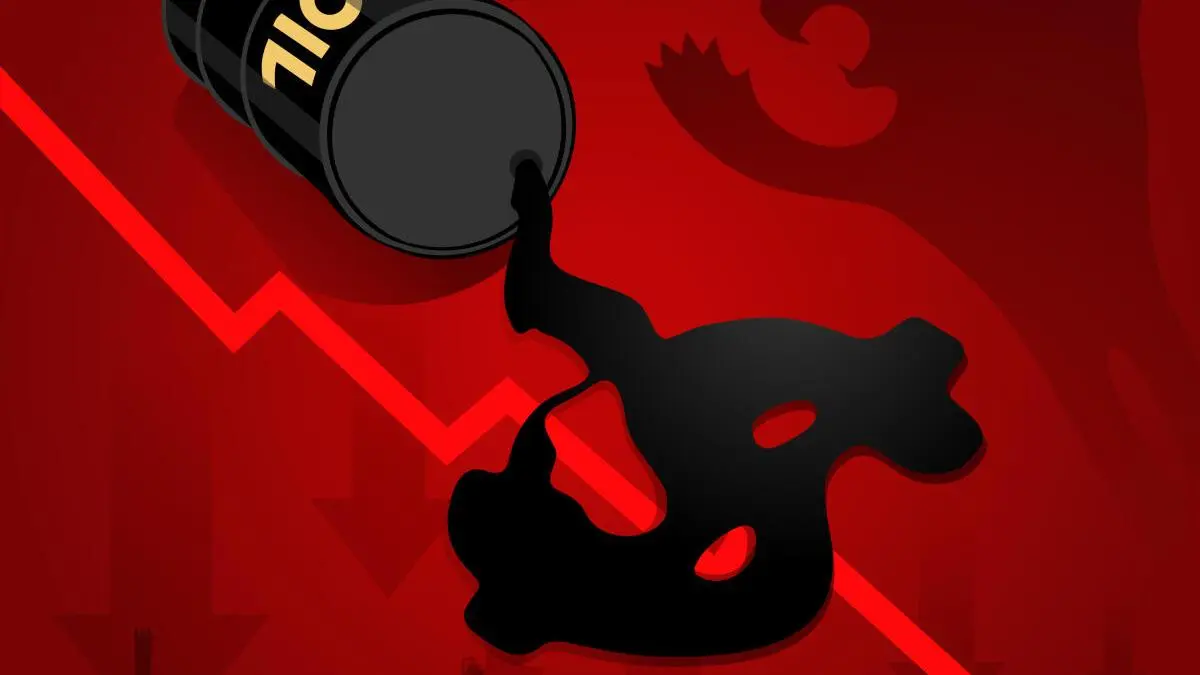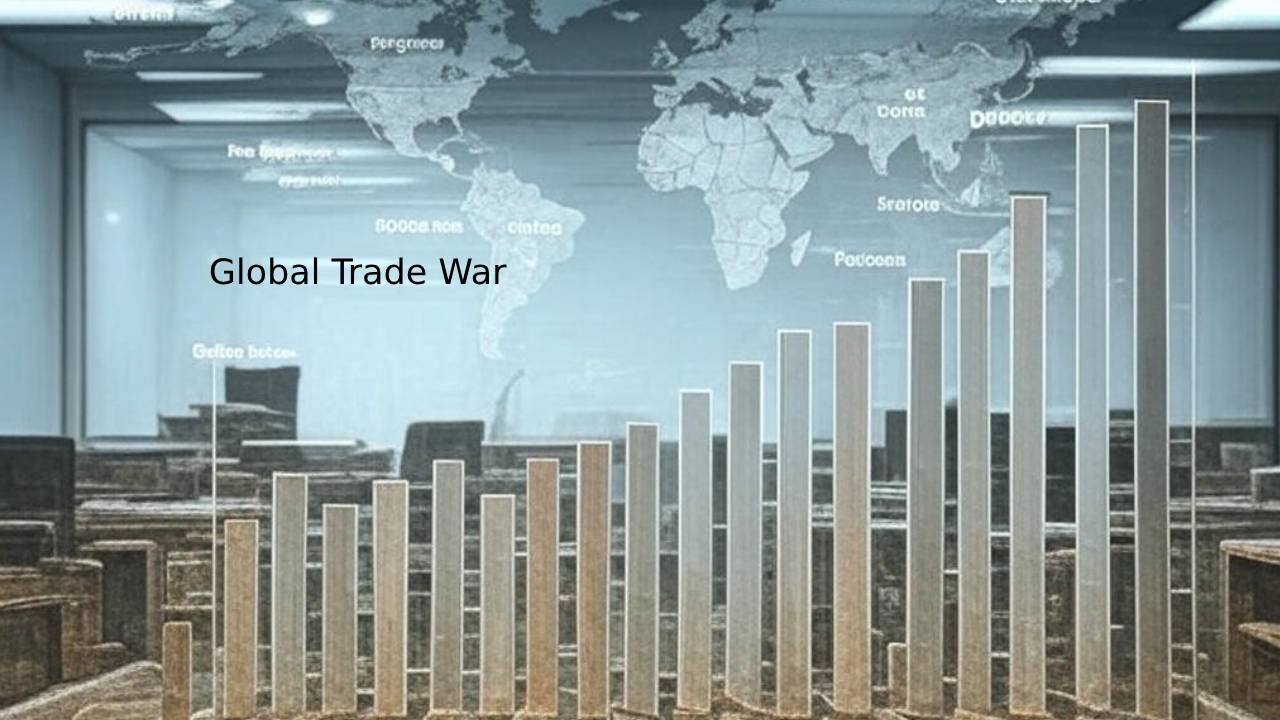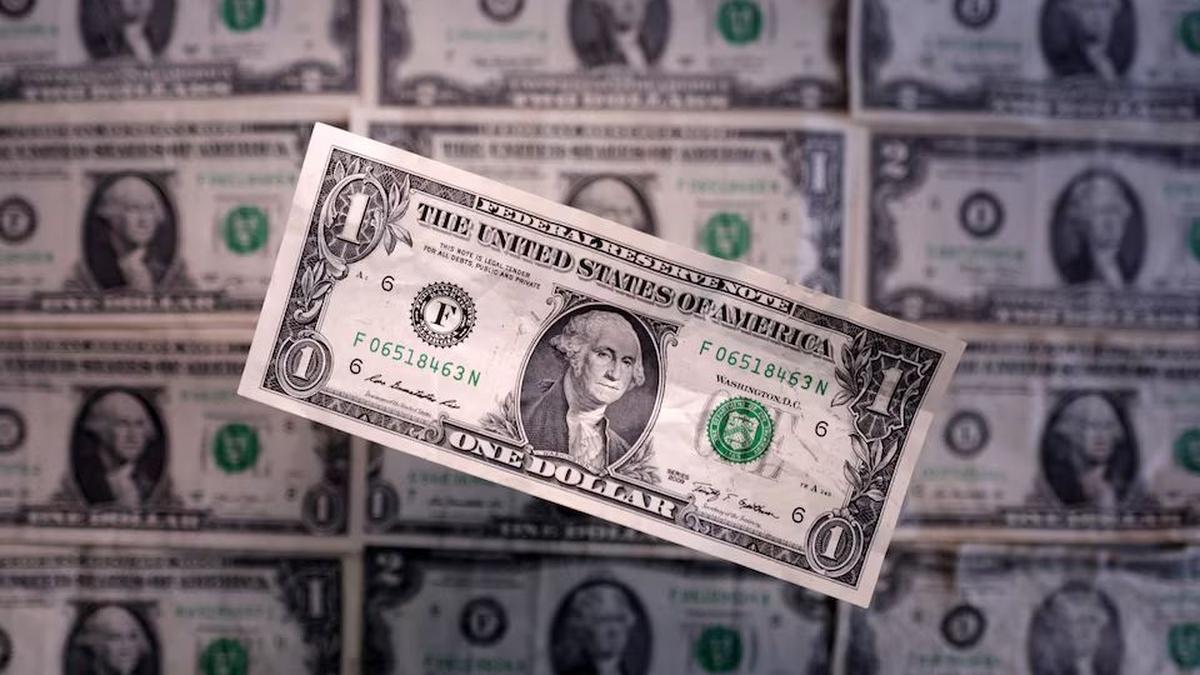Business
Crude Check: Bears hold ground

Trade strategy: Traders can short crude oil futures (April) at ₹5,400 and place a stop-loss at ₹5,550. When the contract declines to ₹5,100, tighten the stop-loss to ₹5,350. Liquidate the longs at ₹4,800. Risk-averse traders can stay away from this trade.
Brent futures ($64.80)
For the contract to turn the outlook positive, it should cross over the key resistance level of ₹5,750. Until then, bears will be at an advantage.However, the contract fell short of surpassing the resistance at . So long as the contract lies below this level, there will be a bearish bias.A resumption in downtrend from the current level can drag the contract to and then possibly to .After witnessing high volatility over the last week, crude oil prices settled marginally lower. The Brent crude oil futures on the Intercontinental Exchange (ICE) (.80/barrel) was down 1.2 per cent. Whereas the crude oil futures on the MCX (₹5,302/barrel) lost a marginal 0.2 per cent.
MCX-Crude oil (₹5,302)
On the other hand, in case the contract cracks the barrier at , it can move up to -70.70 price band.Published on April 12, 2025 However, the contract has resistance levels ahead at ₹5,450 and ₹5,750. Also, the broader bias is bearish.The April crude oil futures tumbled to mark a low of ₹4,798 on Wednesday. But there was an intraday recovery where the contract closed at ₹5,302. So, the price level of ₹5,000 is relevant as a support.Brent crude oil futures saw a zig-zag movement last week. In the first half, it fell to mark a four-year low of .40. But then, it surged back quickly. So, if crude oil futures starts falling again, it can retest ₹4,800. A breach of this can drag the contract to ₹4,700 and then possibly to ₹4,300 if the bears retain the strength.


The April crude oil futures tumbled to mark a low of ₹4,798 on Wednesday. But there was an intraday recovery where the contract closed at ₹5,302. So, the price level of ₹5,000 is relevant as a support.
Brent futures ($64.80)
A resumption in downtrend from the current level can drag the contract to and then possibly to .However, the contract has resistance levels ahead at ₹5,450 and ₹5,750. Also, the broader bias is bearish.Published on April 12, 2025 However, the contract fell short of surpassing the resistance at . So long as the contract lies below this level, there will be a bearish bias.
MCX-Crude oil (₹5,302)
On the other hand, in case the contract cracks the barrier at , it can move up to -70.70 price band.Brent crude oil futures saw a zig-zag movement last week. In the first half, it fell to mark a four-year low of .40. But then, it surged back quickly. For the contract to turn the outlook positive, it should cross over the key resistance level of ₹5,750. Until then, bears will be at an advantage.After witnessing high volatility over the last week, crude oil prices settled marginally lower. The Brent crude oil futures on the Intercontinental Exchange (ICE) (.80/barrel) was down 1.2 per cent. Whereas the crude oil futures on the MCX (₹5,302/barrel) lost a marginal 0.2 per cent.So, if crude oil futures starts falling again, it can retest ₹4,800. A breach of this can drag the contract to ₹4,700 and then possibly to ₹4,300 if the bears retain the strength.Trade strategy: Traders can short crude oil futures (April) at ₹5,400 and place a stop-loss at ₹5,550. When the contract declines to ₹5,100, tighten the stop-loss to ₹5,350. Liquidate the longs at ₹4,800. Risk-averse traders can stay away from this trade.
Business
From fortress to fallout: Trump’s trade moves shake dollar confidence

But even if it does prove short-lived, any erosion of the dollar’s standing as a safe-haven is bad news for investors.”The U.S., almost overnight, it seems to have lost its safe-haven attributes,” said Ray Attrill, head of FX strategy at National Australia Bank.In just a week, the dollar has gone from a safe haven to investors’ whipping boy as U.S. President Donald Trump’s chaotic tariffs on friend and foe alike undermine decades of trust in the world’s reserve currency.To be sure, some believe the dollar selloff could be temporary.”The whole premise of the dollar as a reserve currency is being challenged, effectively, by what we’ve seen since Trump’s election,” said Attrill.”By losing or diminishing credibility as a financial safe haven, the willingness of creditors to lend money to the U.S. is reduced,” he said.For those who have piled trillions of dollars into buoyant U.S. markets in recent decades, a sharp dollar fall could result in higher interest rates for longer as price pressures at home persist, which is bad for bonds and equities.But Trump’s recent moves on trade have shaken perceptions. In a matter of days he has imposed hefty tariffs on the world, made an abrupt U-turn on his decision and intensified a trade war with China, throwing into question the reliability of the U.S. administration.”There is … a loss of confidence to some extent … you’re overlaying that with the loss of exceptionalism and the view that in the short-term, at least, it’s the U.S. economy that’s going to be suffering more than any other from what’s happening on the tariff front.”Things are so bad that the U.S. now has to pay investors more to borrow their money than Italy, Spain or Greece.The sudden loss of confidence was nowhere more stark than in the Treasury market, which saw the largest weekly increase in borrowing costs since 1982 as offshore funds fled.Published on April 11, 2025 It was the establishment of the Bretton Woods system in 1944 that cemented the greenback’s global standing. Post-war planners devised a system built on exchange rate stability and deepening international trade and the dollar remained dominant even after Bretton Woods broke down in the early 1970s.”Regardless of how the next 90 days evolve, the U.S.’s international reputation has been eroded,” ANZ group chief economist Richard Yetsenga said in a note.”Once the uncertainty is more or less gone, the tariff rates are set, there’s no back and forth, we’ll see the dollar getting stronger again because the eventuality is that the tariffs are set in place and this is the new normal,” said Francis Tan, chief strategist for Asia at Indosuez Wealth Management.Martin Whetton, head of financial markets strategy at Westpac, said this week’s massive shift in U.S. dollar swap spreads, the “sharp flash-crash” move higher in U.S. Treasury yields and the heavy selloff in the dollar showed “a stripping away of the shield of liquidity and safety”.The dollar, already on course for its worst year since 2017 , on Friday plunged to a decade-low against the Swiss franc and dropped to its weakest level against the euro in more than three years.Foreigners owned trillion of U.S. debt and stocks at the end of 2024.

“The Trump administration’s ambitious agenda to reform the international financial system seems almost oblivious to the reality of America’s extreme dependence on foreign capital as reflected in its net international investment position,” said Chris Wood, global head of equity strategy at Jefferies, in a note.
Stocks globally have shed trillions of dollars and world markets have gone into a tailspin. Published on April 11, 2025 “By losing or diminishing credibility as a financial safe haven, the willingness of creditors to lend money to the U.S. is reduced,” he said. Foreigners owned trillion of U.S. debt and stocks at the end of 2024.
“Regardless of how the next 90 days evolve, the U.S.’s international reputation has been eroded,” ANZ group chief economist Richard Yetsenga said in a note.”The U.S., almost overnight, it seems to have lost its safe-haven attributes,” said Ray Attrill, head of FX strategy at National Australia Bank. But Trump’s recent moves on trade have shaken perceptions. In a matter of days he has imposed hefty tariffs on the world, made an abrupt U-turn on his decision and intensified a trade war with China, throwing into question the reliability of the U.S. administration.
Martin Whetton, head of financial markets strategy at Westpac, said this week’s massive shift in U.S. dollar swap spreads, the “sharp flash-crash” move higher in U.S. Treasury yields and the heavy selloff in the dollar showed “a stripping away of the shield of liquidity and safety”.”There is … a loss of confidence to some extent … you’re overlaying that with the loss of exceptionalism and the view that in the short-term, at least, it’s the U.S. economy that’s going to be suffering more than any other from what’s happening on the tariff front.”Things are so bad that the U.S. now has to pay investors more to borrow their money than Italy, Spain or Greece.In just a week, the dollar has gone from a safe haven to investors’ whipping boy as U.S. President Donald Trump‘s chaotic tariffs on friend and foe alike undermine decades of trust in the world’s reserve currency.
“Once the uncertainty is more or less gone, the tariff rates are set, there’s no back and forth, we’ll see the dollar getting stronger again because the eventuality is that the tariffs are set in place and this is the new normal,” said Francis Tan, chief strategist for Asia at Indosuez Wealth Management.It was the establishment of the Bretton Woods system in 1944 that cemented the greenback’s global standing. Post-war planners devised a system built on exchange rate stability and deepening international trade and the dollar remained dominant even after Bretton Woods broke down in the early 1970s.To be sure, some believe the dollar selloff could be temporary.
“The global economy is in a weaker position than it was before the tariffs. “The sudden loss of confidence was nowhere more stark than in the Treasury market, which saw the largest weekly increase in borrowing costs since 1982 as offshore funds fled.”The whole premise of the dollar as a reserve currency is being challenged, effectively, by what we’ve seen since Trump’s election,” said Attrill. For those who have piled trillions of dollars into buoyant U.S. markets in recent decades, a sharp dollar fall could result in higher interest rates for longer as price pressures at home persist, which is bad for bonds and equities.But even if it does prove short-lived, any erosion of the dollar’s standing as a safe-haven is bad news for investors.The dollar, already on course for its worst year since 2017 , on Friday plunged to a decade-low against the Swiss franc and dropped to its weakest level against the euro in more than three years.
Business
China Hits Back with 125% Tariffs on US Imports Amid Escalating Trade Tensions
In a bold move, China has raised tariffs on US imports to a staggering 125%, up from 84%, as a direct response to the Trump administration’s recent 145% tariffs on Chinese goods.

In a bold move, China has raised tariffs on US imports to a staggering 125%, up from 84%, as a direct response to the Trump administration’s recent 145% tariffs on Chinese goods. This tit-for-tat escalation, announced on Friday, April 11, 2025, signals a deepening trade war between the world’s two largest economies. The decision has sent ripples through global markets, raising concerns about supply chain disruptions and economic stability.
Why China Imposed Higher Tariffs
The Chinese Commerce Ministry stated that the new tariffs are a countermeasure to what it calls “unilateral bullying” by the US. Alongside the tariff hike, China has taken its grievances to the World Trade Organization (WTO), filing a lawsuit to challenge the US levies. Beijing also expressed openness to dialogue, emphasizing a desire to resolve the trade dispute through negotiations, though tensions remain high.
This latest move follows a series of retaliatory actions. Earlier this week, China imposed 84% tariffs on US goods after President Trump increased duties on Chinese exports to 125%. The back-and-forth reflects a broader struggle for economic dominance, with both nations unwilling to back down.
Impact on Global Trade
The escalating tariffs are already shaking up global markets. Asian and European stock indices dropped as investors grappled with fears of a prolonged trade war. For consumers and businesses, the higher tariffs could mean pricier goods, disrupted supply chains, and potential economic slowdowns. Industries like manufacturing, agriculture, and technology, which rely heavily on US-China trade, are bracing for the fallout.
China’s finance ministry didn’t hold back, criticizing the US tariffs as a violation of international trade rules. “This is a numbers game that will hurt everyone,” a ministry spokesperson remarked, warning of the broader consequences for global commerce.
What’s Next for US-China Relations?
While China has signaled a willingness to talk, the path to resolution looks rocky. The US has paused tariffs on other countries for 90 days to encourage negotiations, but China was excluded from this reprieve. Beijing’s response—doubling down with higher tariffs and legal action—suggests it’s digging in for a long fight.
As the trade war heats up, all eyes are on how both nations will navigate this high-stakes standoff. Will cooler heads prevail, or are we headed for even more economic turbulence? For now, the world watches and waits.
World
Trump pauses tariffs on most nations for 90 days, hikes China import tax to 125%
Facing a global market meltdown, President Donald Trump on Wednesday abruptly backed down on his tariffs on most nations for 90 days, but raised his tax rate on Chinese imports to 125 per cent. It was seemingly an attempt to narrow what had been an unprecedented trade war between the US and most of the […]

🇨🇳125% TARIFF ON CHINA
🌎90-DAY PAUSE & LOWERED 10% RECIPROCAL TARIFF FOR OTHER COUNTRIES
Published on April 9, 2025 Global markets surged on the development, but the precise details of Trump’s plans to ease tariffs on non-China trade partners were not immediately clear. — The White House (@WhiteHouse) April 9, 2025
NEW TRUTH SOCIAL FROM PRESIDENT TRUMP:
-

 india2 years ago
india2 years ago“Major Crash of Sukhoi Su-30 and Mirage 2000 Fighter Jets in Madhya Pradesh”
-

 Sports2 years ago
Sports2 years agoWFI meetings on April 16, elections likely to be discussed
-

 india1 year ago
india1 year agoPM Modi Meets Deve Gowda for Seat Sharing Talks
-

 india1 year ago
india1 year agoBengaluru: False threat to bomb Raj Bhavan
-

 india2 years ago
india2 years ago“AIMIM to Contest 50 Seats in Upcoming Telangana Assembly Elections”
-

 Entertainment1 year ago
Entertainment1 year agoAnant Ambani: Controversy at the Ambani Pre-Wedding Bash
-

 Entertainment2 years ago
Entertainment2 years agoRajinikanth is Moideen Bhai in ‘Lal Salaam’
-

 Videos2 years ago
Videos2 years agoBidar News : Press Meet Organized By Zilla Kannada Sahitya Parishad














